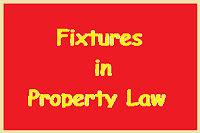Hello Reader, this time Tabir Hukum will discuss about fixtures in property law.
In the common law world, freehold estates and most other interests in land are categorized as real property, and all other property, including leasehold estates, are categorized as personal property. A building on land is generally treated as part of the land itself; thus, when one buys a house on a city lot, or a farm property complete with house, barns and implement sheds, the legal description of the property identifies the boundaries of the land, but does not itemize the buildings constructed on the land. For those who like Latin maxims, the relevant one is quicquid plantatur solo, solo credit (that which is attached to the soil becomes part of the of the soil). Goods, known in legal parlance as chattels, may also become part of the land, if they are attached to the land or to structures that are considered part of the land so as to become fixtures.
In determining whether an item has sufficient attachment so as to become a fixture, judges ask whether a reasonable person, looking at the degree and purpose of attachment, would conclude that the item was intended to become a permanent part of the land. Items that are securely and permanently attached to land or a structure on the land in order to make better use of the land or a structure on the land in order to make better use of the land become fixtures. The word "permanently" must be understood not as meaning "forever" but as meaning "for as long as the item serves its purpose of enhancing the value or the usefulness of the land".
Because the categorization in each case depends on how judge views the particular facts, the same kind of chattel may be a fixture in some settings and not in others. As Bruce Ziff observes, the "structurally equivocal dwelling known as a 'mobile home' illustrates this indeterminacy, since the case law on whether mobile homes are fixtures divides into two camps. None of the mobile home rulings is necessarily wrong' so much depends on the facts". (Principles of Property Law, 3rd ed., p. 106).
As in any situation where legal rights rest on sometimes obscure legal distinctions, parties can use contracts to ensure that the legal consequences of a transaction will match their expectations. If, on the facts, something is a fixture, a contract cannot make it into a chattel by calling it a chattel. But the parties to a contract for the sale of real estate can, for example, write into their agreement of purchase and sale that the vendor will remove the crystal chandelier in the dining room and repair any damage before completion of the sale, or that the purchase includes the mirror over the mantle, the wall-to-wall carpeting, and the dock and changing shed that are hauled up to the boat house for winter storage.
Umpteen posts of tabir hukum about fixtures in property law, hopefully the writing of tabir hukum about fixtures in property law can be beneficial.
Books : In Writing Tabir Hukum :
Alan M. Sinclair and Margaret E. McCallum, 2005. An Introduction to Real Property Law (Fifth Edition). LexisNexis : Canada.



